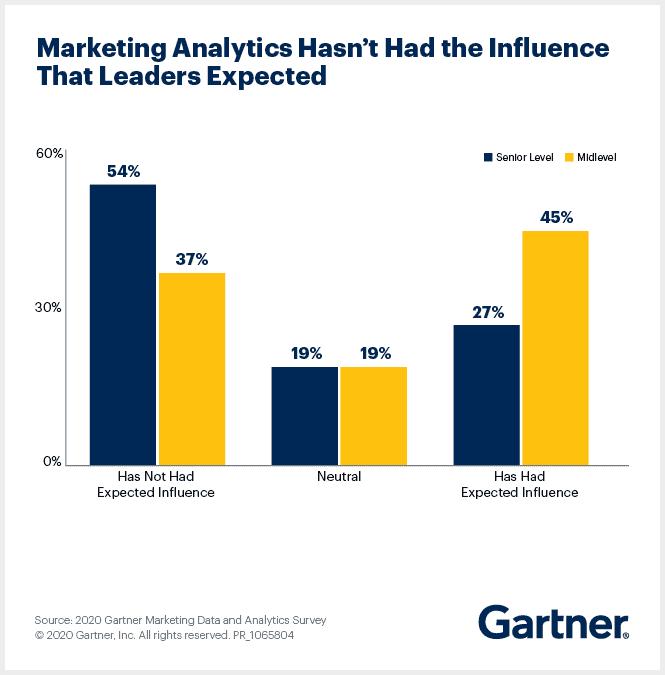Despite CMOs prioritizing investments in marketing data and analytics, more than half of senior marketing leaders are unimpressed by their results, says Gartner.
The Gartner Marketing Data and Analytics Survey 2020 revealed that as a result only 54% of marketing decisions are being influenced by marketing analytics (see Figure 1).
Gartner surveyed 415 marketing leaders and analytics practitioners June 2020 through July 2020 in North America and Western Europe to better understand the current approaches to marketing analytics that support marketing strategies to enable future growth and success. The survey results indicate that marketing analytics has not had the impact that marketing leaders expected.
“Though CMOs understand the importance of applying analytics throughout the marketing organization, many struggle to quantify the relationship between insights gathered and their company’s bottom line. In fact, nearly half of respondents in this year’s survey say they’re unable to measure marketing ROI,” said Lizzy Foo Kune, senior director analyst in the Gartner Marketing practice. “This inability to measure ROI tarnishes the perceived value of the analytics team.”
Figure 1. Marketing analytics has not had the influence that leaders expected

Marketers also cite poor data quality, inactionable results and the lack of clear recommendations as the top reasons for not relying on marketing analytics to make decisions. Another reason is that data findings conflict with their intended course of action.
“Confirmation bias plays a large role here,” said Foo Kune. “Marketing leaders often seek out data to help them make the case for a desired course of action or to show the value of their program. However, marketers must understand that having data that conflicts with a planned course of action is valuable and presents a unique opportunity to further challenge controversial findings through experimentation.”
Other key findings:
Focus more on skill development
Only 23% of respondents said they prioritized spending time on skill development in this year’s survey, ranking lowest among all other analytics activities. This shows that analytics teams are deprioritizing skill development during a time where it may be needed most.
Most room for growth
Data science and campaign analysis are the top two areas where analytics has the most ground to make up to meet the expectations of senior marketing leaders. However, Gartner research finds that marketers are deprioritizing investment in these areas. Instead, investments are being allocated to web and mobile analytics and customer analytics, where marketing analytics teams are closer to meeting expectations.
Optimism paves way for future growth
Despite challenges in utilizing marketing analytics to make actionable and informed marketing decisions, investments in marketing analytics continues. Year after year, Gartner’s CMO Spend Survey shows CMOs ranking marketing analytics as a top area of investment, with 73% of respondents surveyed in 2020 planning to increase investments in the next fiscal year.
Respondents of the Gartner survey echoed a similar optimism, with 44% of respondents planning to increase their marketing analytics team size over the next two years; only 18% expect their team size will shrink over that same timespan. Furthermore, 85% of respondents feel that by 2022, “significantly more” of their organization’s marketing decisions will be based on marketing analytics. “Marketing leaders are either optimistic about the future potential of marketing analytics or have invested too much to turn around now,” said Foo Kune. “Either way, there is still an opportunity for marketing analytics to deliver on senior marketers’ expectations and increase its impact on key business outcomes.”





